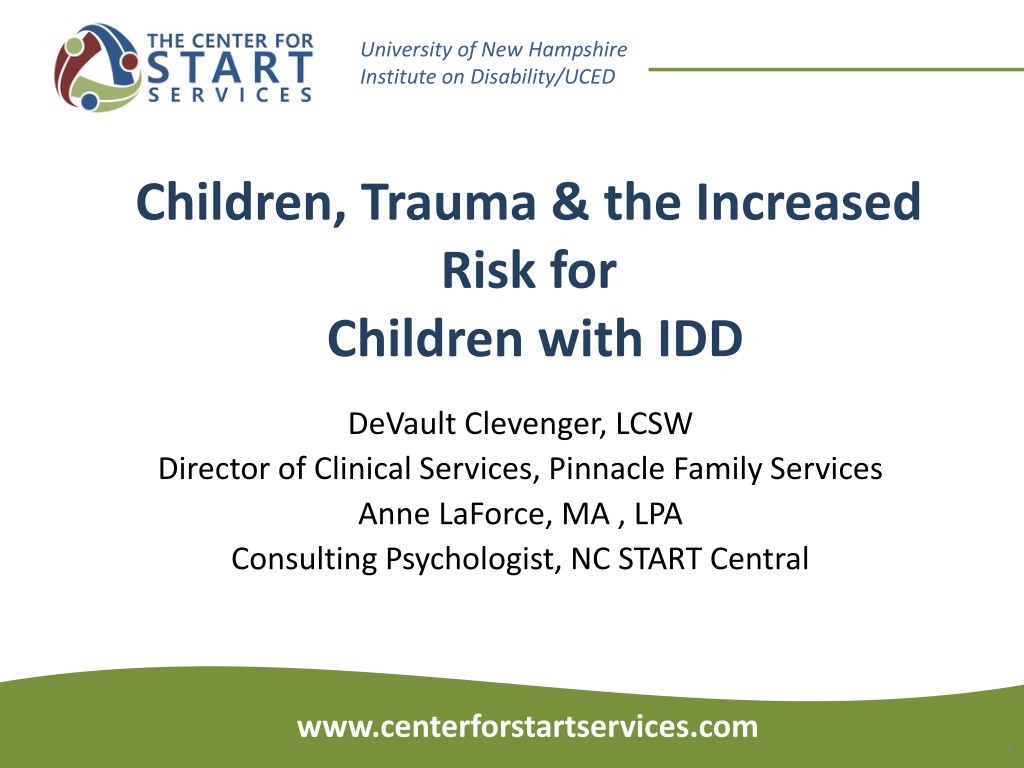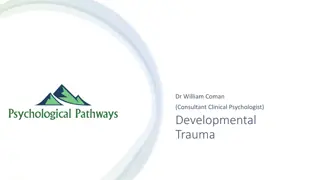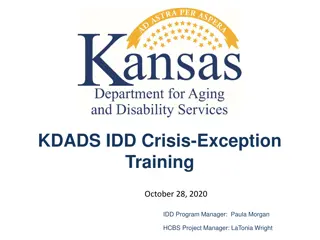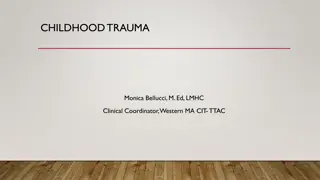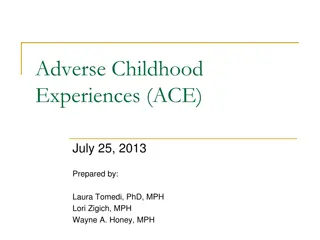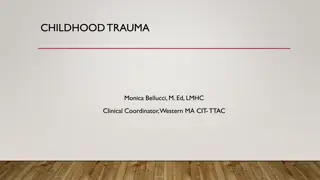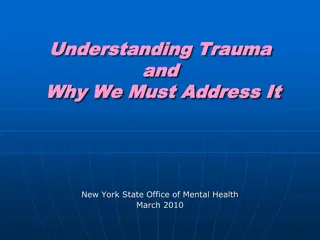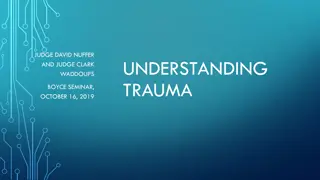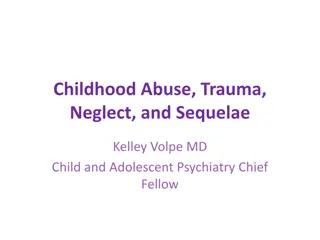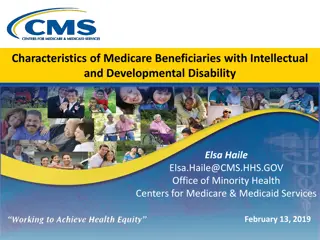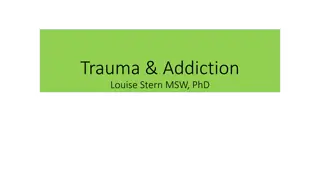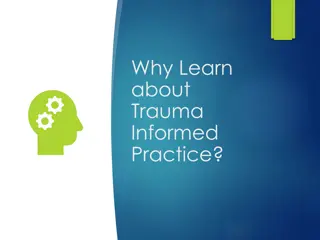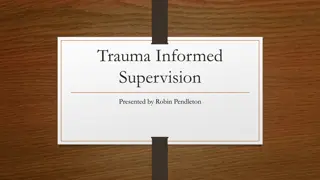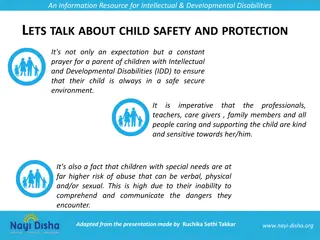Understanding Childhood Trauma and Its Impact on Children with IDD
Childhood trauma, defined as intense and overwhelming experiences causing harm to physical and emotional well-being, can have severe repercussions on children with Intellectual and Developmental Disabilities (IDD). This article discusses the concept of trauma, provides examples of traumatic experiences, and highlights the Adverse Childhood Experiences (ACE) Study's findings on the long-term effects of such trauma. Through a case example of a 12-year-old with Autism and Moderate IDD, the challenges and behaviors associated with trauma in children with IDD are explored, emphasizing the need for specialized support and intervention strategies.
Download Presentation

Please find below an Image/Link to download the presentation.
The content on the website is provided AS IS for your information and personal use only. It may not be sold, licensed, or shared on other websites without obtaining consent from the author. Download presentation by click this link. If you encounter any issues during the download, it is possible that the publisher has removed the file from their server.
E N D
Presentation Transcript
University of New Hampshire Institute on Disability/UCED Children, Trauma & the Increased Risk for Children with IDD DeVault Clevenger, LCSW Director of Clinical Services, Pinnacle Family Services Anne LaForce, MA , LPA Consulting Psychologist, NC START Central www.centerforstartservices.com 1
University of New Hampshire Institute on Disability/UCED Case Example Jimmy Part 1 12 y-o Diagnosis Autism, Moderate ID, Psychosis NOS Presenting problem: Physical aggression, running away, self- injury, attention-seeking behavior at school Multiple hospitalizations Reports explosive episodes that come out of nowhere
University of New Hampshire Institute on Disability/UCED What is Trauma? Trauma refers to intense and overwhelming experiences that involve serious loss, threat or harm to a person s physical and/or emotional well being. These experience may occur at any time in a person s life. They may involve a single traumatic event or may be repeated over many years. These trauma experiences often overwhelm the persons coping resources. This often leads the person to find a way of coping that may work in the short run but may cause serious harm in the long run.
University of New Hampshire Institute on Disability/UCED Examples of Trauma Physical, emotional and/or sexual abuse in childhood or adulthood Rape Serious medical illness or disease (disabling conditions, loss of function, invasive and distressing procedures) Involved in or witnessing horrific events (natural disasters, terrorism) In Childhood o neglect or abandonment (food insufficiency, lack of money to met basic needs, homelessness) o death of a parent o Divorce o Domestic violence o family life that includes drug addiction, alcoholism, parental incarceration, violence
University of New Hampshire Institute on Disability/UCED What is the Adverse Childhood Experiences (ACE) Study? Center for Disease Control and Kaiser Permanente (an HMO) Collaboration Over a ten year study involving 17,000 people Looked at effects of adverse childhood experiences (trauma)over the lifespan Largest study ever done on this subject
University of New Hampshire Institute on Disability/UCED People enrolled in the Kaiser Permanente health plan were asked ten questions related to the following adverse childhood experiences . Physical, emotional and/or sexual abuse Neglect or abandonment Divorce Alcoholism or drug addiction in the family Family violence Poverty, homelessness, lack of food and basic needs Family member in prison Family member with mental illness 6
University of New Hampshire Institute on Disability/UCED The 17,000 people who answered these questions were . 80% White, including Hispanic 50% men, 50% women 74% had attended college 10% Black 10% Asian 62% age 50 or older 7
University of New Hampshire Institute on Disability/UCED What They Found Of the 17,000 respondents 1 in 4 exposed to 2 categories of ACEs 1 in 16 was exposed to 4 categories. 22% were sexually abused as children. 66% of the women experienced abuse, violence or family strife in childhood. Women were 50% more likely than men to have experienced 5 or more ACEs 8
University of New Hampshire Institute on Disability/UCED Impact of Childhood Trauma Over the Lifespan Impact is neurological, biological, psychological and social in nature. They include: Changes in brain neurobiology; Social, emotional & cognitive impairment; Adoption of health risk behaviors as coping mechanisms (eating disorders, smoking, substance abuse, self harm, sexual promiscuity, violence); and Severe and persistent behavioral health, health and social problems, early death. (Felitti et al, 1998) 9
University of New Hampshire Institute on Disability/UCED Multiple childhood trauma experiences raise the risk for Anxiety problems and fears > Avoiding people, places and things that are similar to or reminders of the traumatic event(s) Physical health problems Sleep problems Emotional problems such as feeling numb and/or disconnected from oneself or environment Memory problems Flashbacks Bottom line findings: Traumatic experiences raises the individuals risk for severe emotional distress, suicide, physical illness, substance abuse and a host of other life difficulties 10
University of New Hampshire Institute on Disability/UCED Trauma- and Stressor- Related Disorders (DSM-5) Posttraumatic Stress Disorder Posttraumatic Stress Disorder for Children 6 and under Acute Stress Disorders Reactive Attachment Disorder Disinhibited Social Engagement Disorder Adjustment Disorders 11
University of New Hampshire Institute on Disability/UCED Post Traumatic Stress Disorder (PTSD) Exposure to actual or threatened death or serious harm (direct, witnessing, learning of violent event for close family member/friend) Intrusive Symptoms reliving Avoidance Alteration on cognition and mood Alterations in arousal and reactivity 12
University of New Hampshire Institute on Disability/UCED Not everyone who experiences trauma develops PTSD o BUT people have long lasting effects due to trauma We need to presume the clients we serve have a history of traumatic stress and exercise universal precautions by creating systems of care that are trauma-informed. (Hodas, 2005)
University of New Hampshire Institute on Disability/UCED The Brain and Executive Function Abstract thought, cognitive memory, decision making, language Stores emotional information Controls heart rate, body temp, other survival-related functions. Also stores anxiety or arousal states associated w/ traumatic event Motor control & motor memory
University of New Hampshire Institute on Disability/UCED Trauma and the Developing Brain Trauma is a neuro-developmental insult and impacts the development of the brain as well as psychological processes Traumatic exposure disrupts the development of self- regulatory processes leading to chronic affect dysregulation, destructive behavior towards self and others, learning disabilities, dissociative problems, somatization, and distortions in concepts of self and others The brain responds differently after trauma less executive functioning and more fight or flight 15
University of New Hampshire Institute on Disability/UCED The Brain & Trauma When we are calm, it is easy to live in our cortex, using the highest capacities of our brains to contemplate abstractions, make plans, dream of the future, read, make rational decisions. As we move up the arousal continuum toward fear, then we necessarily rely on lower and faster brain regions. In complete panic, our responses are reflexive and under virtually no conscience control. Fear quite literally makes us dumber , a property that allows faster reactions in short periods of time and helps immediate survival. But fear can become maladaptive if it is sustained or intense; the threat system becomes sensitized to keep us in this state constantly.
University of New Hampshire Institute on Disability/UCED The Brain and Trauma Survival/Trauma Brain
University of New Hampshire Institute on Disability/UCED Survival Brain vs. Learning Brain We all have alarm systems in our brain/body that let us know when we are under threat and mobilize us to fight, flight or freeze in the face of a threat. When children experience continuous threats/trauma, the brain/body is put into chronic state of fear activating the survival brain (mid/lower areas of the brain) Can create an overactive alarm system in the developing brain a child s brain/body that develops within the context of trauma can be more easily triggered into survival brain by trauma reminders or triggers even when there is not actual threat. 18
University of New Hampshire Institute on Disability/UCED Fight/Flight Because of constant exposure to violence and trauma, children can become locked into a permanent state of Fight/Flight This makes these children react to normal experiences as if they were life and death threats This is not a rational/cognitive process. It is wired into their physiological response There is also Freeze this can look like: o just not there o Can be misinterpreted as non-compliance 19
University of New Hampshire Institute on Disability/UCED Bruce Perry Persistent trauma leads to a dysregulated brain stem which manifests with symptoms such as impaired cardiovascular regulation, extreme affective lability, and poor impulse control. People who are aroused from fear cannot take in cognitive information. They are too busy watching for threatening gestures, and not able to listen to what is being said. Verbal warnings or rational arguments that make demands on higher functions (frontal lobe) may escalate the situation as children are physiologically unable to access these functions when they are in a triggered state language centers of the brain are shut down
University of New Hampshire Institute on Disability/UCED Left vs. Right Brain There are differences between the left and right sides of the brain Usually they work together seamlessly o Left facts, statistics, language, sequencing o Right memories of sound, touch, smell, emotions During re-experiencing trauma (reminders of past) the left hemisphere shuts down Broca s area is in the left side and controls speech So what does this mean?You can t talk/reason someone out of trauma Talking to someone is different than using calming phrases 21
University of New Hampshire Institute on Disability/UCED Children who have experienced trauma Can have difficulty with: Managing big emotions Chronic irritability/anxiety that interferes with problem solving Empathy Expressing concerns/needs into words Taking into account the wider context of a situation Appreciating how one s behavior impacts other people Working in groups/connecting with others 22
University of New Hampshire Institute on Disability/UCED the state becomes a trait Rather than recognizing a fear-based brain state, or attempt to manage or prevent fear, a person may be diagnosed incorrectly with: o Psychotic Disorder o Bipolar Disorder o Borderline Personality Disorder o Intermittent Explosive Disorder o Oppositional Defiant Disorder o Disruptive Behavior Disorder o Obsessive Compulsive Disorder
University of New Hampshire Institute on Disability/UCED Jimmy Part 2 12 y-o Diagnosis Autism, Mild ID, Psychosis NOS Presenting problem: Physical aggression, running away, self-injury, attention-seeking behavior at school Multiple hospitalizations Reports explosive episodes that come out of nowhere What else do you need/want to know? Why?
University of New Hampshire Institute on Disability/UCED Trauma in IDD Estimated 90% of individuals with IDD have experienced trauma Individuals with disabilities are 4-10 times more likely to be sexually abused More likely to experience negative life events, such as serious illness or injury Little T s trauma can include illness, hospitalization, separation from family, domestic violence, neglect, frequent changes in caregivers Life losses may result in complicated or traumatic grief Traumatic exposure disrupts the development of self-regulatory processes, leading to o Chronic emotional dysregulation, destructive behavior towards self and others, dissociative problems, somatization and distortions in concepts of self and others 25
University of New Hampshire Institute on Disability/UCED DEVELOPMENTAL EFFECTS on Trauma Responses Developmental level has been found to have a major impact on individuals capacity to cope with traumatic events o there are indications that early separation from parents through early institutionalization or hospital admissions, fewer previous experiences in managing negative life events, and a limited capacity for gathering social support may make people with ID more vulnerable for the development of PTSD. o different kinds of problem behaviors can be considered as symptoms of PTSD, such as aggression and anger outbursts, self-injurious behavior, non-compliance, social isolation, sleeping problems, and restlessness. Mevissen, L., & De Jongh, A. (2010). PTSD and its treatment in people with intellectual disabilities: A review of the literature. Clinical Psychology Review, 30(3), 308-316.
University of New Hampshire Institute on Disability/UCED BioPsychoSocial Factors that Contribute to Risk Biological: o Sometimes impaired mobility o Medical treatments/health care needs, physically dependent on others Psychological/Cognitive: o Sometimes impaired in ability to communicate o Cognitive and processing delays that interfere with understanding what is happening in abusive situations o IQ influences the likelihood both of exposure to traumatic events and the development of PTSD if exposed the lower the IQ the higher the risk 27
University of New Hampshire Institute on Disability/UCED BioPsychoSocial Factors that Contribute to Risk Social o Trained to be compliant o Dependent on caregivers for longer; often have multiple caregivers o Isolated from resources to report o Often not provided with general sex education o Feelings of isolation and withdrawal which may make them more vulnerable to manipulation & exploitation 28
University of New Hampshire Institute on Disability/UCED Effects of Trauma The effect of trauma is increased for people with IDD due to: o A predisposition toward emotional problems and impaired resiliency o A belief that people with IDD cannot benefit from therapy o A lack of trained professionals who are comfortable working with IDD in processing traumatic experiences 29
University of New Hampshire Institute on Disability/UCED PTSD and IDD Intrusive Symptoms Memories, flashbacks, dreams, physiological symptoms Reliving the experience o In IDD, re-experiencing the traumatic event may manifest in symptoms that are more overtly behavioral (concrete) and may include self-injurious behavior and trauma-specific re-enactments. Re-enactments can look quite bizarre and it is important to distinguish such symptoms from psychotic disorder symptoms Avoidance and emotional numbing o IDD, this can sometimes be seen or described as non-compliance Alteration in cognition and mood negative beliefs about self or others, negative emotional state. o In IDD, negative emotional state may present in externalizing behaviors. Alterations in arousal hypervigilance, irritable behavior, exaggerated startle response, aggression. o In IDD, aggressive behavior is often described as coming out of nowhere 30
University of New Hampshire Institute on Disability/UCED PTSD and IDD The diagnosis of PTSD in the population of IDD is complex Intellectual and communication deficits may interfere with the individual's capacity to give a coherent and reliable narrative disclosing trauma experience The burden typically falls upon others to recognize significant changes from baseline behavior which may signal traumatic response, particularly in individuals who are non-verbal or minimally verbal Common referral problems such as noncompliance, self-injury, aggression, outbursts of anger and irritability can be manifestations of PTSD An individual may be misdiagnosed when symptoms of extreme stress reaction are mistaken for "behavioral problems" or other psychiatric disorders
University of New Hampshire Institute on Disability/UCED The good news Our brains grow and change all our lives. The brain can build new connections for feeling safe and avoid over- reacting. When we see the search for safety in behavior, how can we use it to promote healing?
University of New Hampshire Institute on Disability/UCED What Does Not help? Assuming behavior is an attempt to gain a specific outcome or manipulate Assuming the person has control over behavior in a crisis situation Oversimplified focus on contingencies/consequences Restriction or control (fuels feelings of powerlessness and may increase agitation) Expecting that re-exposure or discussing their trauma will decrease outbursts 33
University of New Hampshire Institute on Disability/UCED What Does Help? Positive Supports and Positive Psychology Focus on increasing happiness o Engagement and attachment o Developmentally appropriate expectation o Enhancing relationships Replacement skills o Functional communication o Ability to label feelings, calming skills Positive identity o Focus on strengths o Nurtures sense of identity vs. reducing people to their behavior 34
University of New Hampshire Institute on Disability/UCED Sensory Diets Sensory assessment can identify sensory problems and recommend a sensory diet: Deep breathing Foods to chomp Full-spectrum lighting Earplugs or headphones Essential oils Deep pressure Yoga Movement protocols
University of New Hampshire Institute on Disability/UCED Increase Safety and Comfort Learn trauma triggers Planning to increase feelings of safety Real choices to reduce sense of powerlessness Provide validation and reassurance if someone shares their trauma 36
University of New Hampshire Institute on Disability/UCED Strategies to Address Effects of Trauma Children in a triggered state need help to calm down from the there and then triggers to become more present in the here and now reality (in which there may be no actual threat) Processing trauma is often not helpful can cause re- traumatization, more helpful to address symptoms Important to provide safety and reassurance 37
University of New Hampshire Institute on Disability/UCED In the Moment Reason Cortex Relate Limbic Regulate Brain Stem Bruce Perry
University of New Hampshire Institute on Disability/UCED Move the Activity of the Brain You want to move from brainstem, to limbic, to the cortex. Help them feel safe first Then try a thinking task like sorting cards (by color, by number, etc.) The better the emotional associations with you or the materials, the quicker the task will help clear away the stress response Grounding is a technique that helps keep someone in the present. Grounding helps orient a person to the here-and- now and in reality. Grounding skills can be helpful in managing overwhelming feelings or intense anxiety. They help someone to regain mental focus from an often intensely emotional state. People with trauma/PTSD struggle with either feeling too much (overwhelming emotions and memories) or too little (numbing and dissociation).
University of New Hampshire Institute on Disability/UCED What is calming? Rhythmic moving (walking, drumming, rocking) Repetitive movement of hands (dribbling basketball, running hands through sand or beans) Sensation on hands (warm blanket, stuffed animal) Holding ice cube Smelling peppermint Firm pressure Nature (walking barefoot on grass, smelling flowers)
University of New Hampshire Institute on Disability/UCED The 3 P s We should be: Present reassuring, calm presence Parallel - being present without demands or requiring interaction Patient - waiting it out
University of New Hampshire Institute on Disability/UCED Jimmy Part 3 So let s think back to Jimmy Will you see Jimmy in a different way? Why? Will you interact in a different way? Why?
University of New Hampshire Institute on Disability/UCED Why use a Trauma Informed Approach? We need to presume the clients we serve have a history of traumatic stress and exercise universal precautions by creating systems of care that are trauma-informed (Hodas, 2005) To provide effective services we need to understand the life situations that may be contributing to the persons current problems. The question changes from What is wrong with you? to What happened to you? Focus should be on how do we shift the environment to respond more effectively to your needs? 43
University of New Hampshire Institute on Disability/UCED References & Resources Diagnostic and Statistical Manual of Mental Disorders, 5th Ed. (DSM5) 2013 American Psychiatric Association DM-ID: Diagnostic Manual Intellectual Disability: A Clinical Guide for Diagnosis of Mental Disorders in Persons with Intellectual Disability, 1st Edition 2007 NADD Press The Boy Who Was Raised as a Dog: And Other Stories from a Child Psychiatrist s Notebook. Bruce D. Perry, MD, PhD., & Maia Szalavitz 2007 Basic Books Publishing The Body Keeps the Score: Brain, Mind, and Body in the Healing of Trauma. Bessel Van Der Kolk, M.D. Trauma Focused Cognitive Behavioral Therapy Trauma and Resilience: An Adolescent Provider Toolkit. Adolescent Health Working Group 2013 Emotional Regulation Skills System for Cognitively Challenged Clients. Julie Brown modified DBT 44
University of New Hampshire Institute on Disability/UCED To contact us: DeVault Clevenger devault.clevenger@pinnaclefamilyservices.org Website: www.pinnaclefamilyservices.org Corporate Office: corporate@pinnaclefamilyservices.org Anne LaForce anne.laforce@eastersealsucp.com 45
